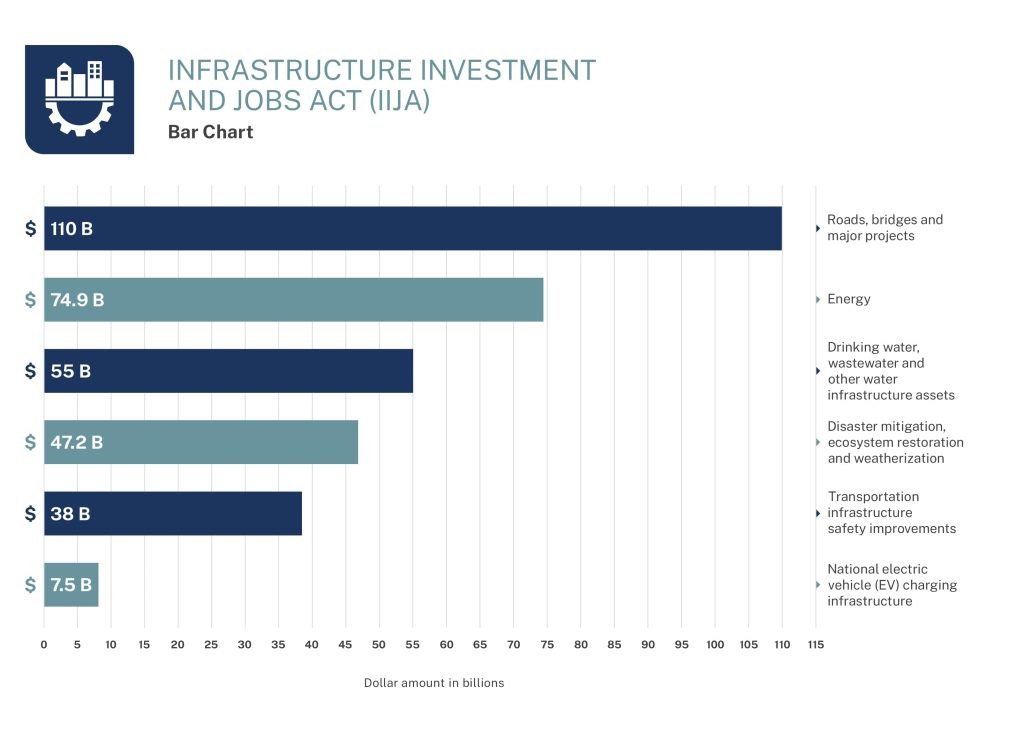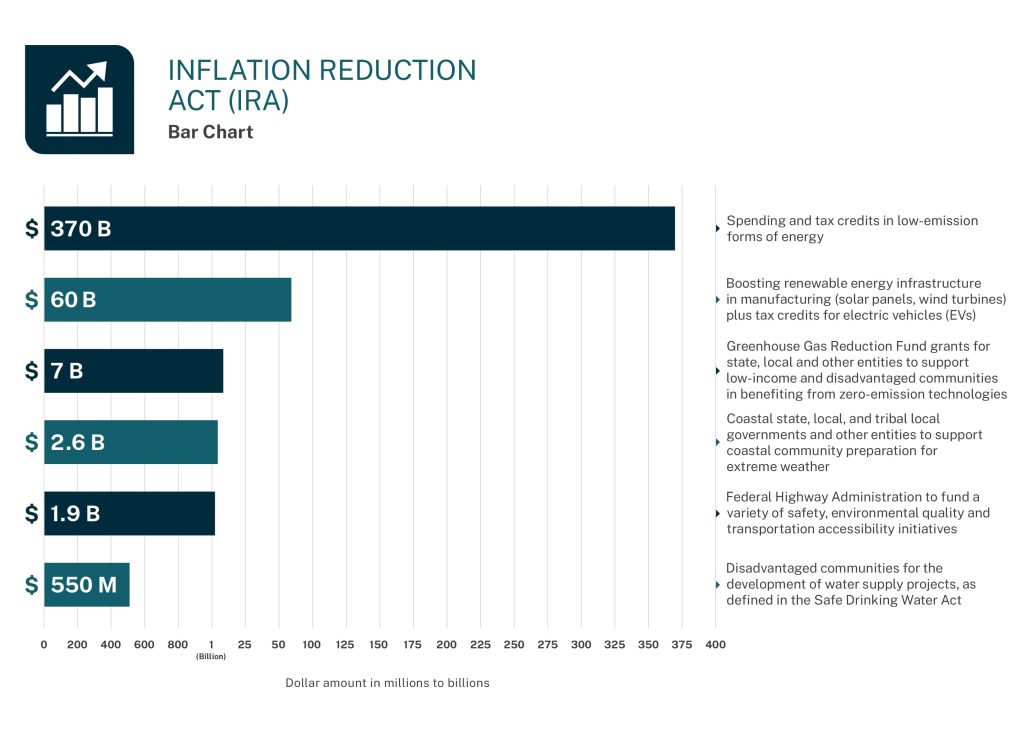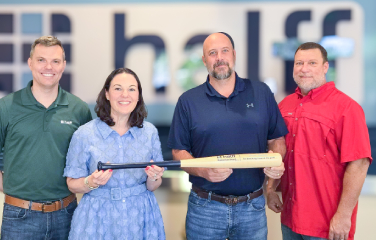What Are the IIJA and IRA? Expert Tips on Planning for Project Funding

Securing funding is vital to a project’s success. Yet finding grants and available funding mechanisms can be challenging, especially while also managing project logistics. Two recently passed acts, the Infrastructure Investment and Jobs Act (IIJA) and the Inflation Reduction Act (IRA), are now supplying billions of dollars to help projects come to fruition.
Learn more about the IIJA, IRA and expert tips from Halff’s Funding Resources team in this article to provide you with a strong foundation of knowledge and practical next steps for project funding.
What Is the IIJA?
The Infrastructure Investment and Jobs Act (IIJA) was passed on Nov. 15, 2021. Also known as the Bipartisan Infrastructure Deal, it administers $1.2 trillion for extensive infrastructure funding. This is the largest investment in local government infrastructure since the New Deal in 1933.
Some of the IIJA funds are apportioned for the following projects:
-
- ($110B) Roads, bridges and major projects
- ($74.9B) Energy
- ($55B) Drinking water, wastewater and other water infrastructure assets
- ($47.2B) Disaster mitigation, ecosystem restoration and weatherization
- ($38B) Transportation infrastructure safety improvements
- ($7.5B) National electric vehicle (EV) charging infrastructure
Funding from IIJA is dispersed in several different ways. State agencies that are allocated funding have statewide competitions for funds, and in some cases, distribute funding directly for state purposes. Similarly, some IIJA funding is allocated directly to units of local government, and some is only made available to them through competitive grants. Most competitive grant applications require registration on Grants.gov.
How Does Funding Work?
Your road map is the Notice of Funding Opportunity or NOFO. It details who is eligible to apply, what the criteria is for application scoring, what information needs to be included in the application and when it is due. Each program is different and there are many. For example, in the transportation sections of the bill alone, there are 13 existing grant programs with expanded funding and 21 new grant programs.
Who Is eligible for IIJA Funding?
Depending on the grant program’s requirements, applicants may include units of local government, states, non-profit organizations, academic institutions and for-profit enterprises.
A project’s benefits to underserved and disadvantaged communities can be crucial eligibility or evaluation criteria for the grant program. It is important to examine the NOFO closely to determine if a project would be competitive based on the community it serves.
What Is the IRA?
The Inflation Reduction Act (IRA), signed on Aug. 16, 2022, provides an additional amount of funding that supports the IIJA. Most of the IRA is dedicated to domestic energy production and renewable energy infrastructure investment. A variety of other projects may be offered grants by the Inflation Reduction Act, such as coastal community preparation, water supply projects, transportation accessibility initiatives and more.
The IRA offers funding in the following areas:
-
- ($370B) Spending and tax credits in low-emission forms of energy
- ($60B) Boosting renewable energy infrastructure in manufacturing (solar panels, wind turbines) plus tax credits for electric vehicles (EVs)
- ($7B) Greenhouse Gas Reduction Fund grants for state, local and other entities to support low-income and disadvantaged communities in benefiting from zero-emission technologies
- ($2.6B) Coastal state, local, and tribal local governments and other entities to support coastal community preparation for extreme weather
- ($1.9B) Federal Highway Administration to fund a variety of safety, environmental quality and transportation accessibility initiatives
- ($550M) Disadvantaged communities for the development of water supply projects, as defined in the Safe Drinking Water Act
Planning Ahead for Project Funding
Preparing your strategy and approach for obtaining funding can make or break your project. Begin by identifying your greatest needs. There are several key areas to examine when planning ahead for project funding:
-
- Your Capital Investment Plan (CIP)
- Completed designs, plans and studies gathering dust on the shelf
- Projects underway with funding gaps/unfunded phases
- Data analysis of your jurisdiction
Availability and restrictions on sources of matching funds will also give you an important gauge on where to focus your efforts. Most grant programs require some level of matching funds to show the applicant’s “skin in the game.” Levels of required match vary in different grant programs and are sometimes also a scored criterion. Applicants can sometimes use funds received from other grant programs, such as Community Development Block Grants (CDBG) or State and Local Coronavirus Fiscal Recovery Funds (also referred to as ARPA), as match for competitive grants. As always, it depends on the grant program as detailed in the NOFO.
The posture of your project must be considered. Determine whether conceptual design, basic cost estimates and budgets are available. Some funds will even require that partnerships are present to apply. Your concept may be solid, but you may not be ready to apply without these building blocks.
Assembling your team will boost the effectiveness of your strategy. Without designated roles to keep the project and processes running, executing the correct application steps will be more difficult. An applicant’s E-Point of Contact (EPOC) in grants.gov must approve submission of applications. The project design, engineering, cost estimate and budget should be organized and assembled. Some applications even require a Benefit-Cost Analysis (BCA) to prove the project’s value. Project oversight is essential to good project management, as having one individual to monitor the work also maintains the relationships needed for the duration of the project.
Last, but not at all least, is having a grant writer. Many benefits and advantages can be lost by not appointing a grant writer to focus on the compilation and presentation of grant applications.
In a sea of grants and funding options, one can navigate the process by employing these preparatory steps. This can help organizations tap into much-needed funding to execute important projects. Not considering the funding needs of a project can create great challenges that inhibit success and timeliness. Carefully thinking ahead on project funding will help your stunning project go from idea to reality.
Need help with funding your projects? Please contact our Funding Resources team to speak with Funding Resources Program Manager Elizabeth Range-Pendell (eRangePendell@Halff.com) or Florida Funding Resources Manager Lisa King (lKing@halff.com).






